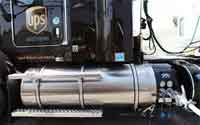UPS has driven more than 350 million miles using alternative fuel vehicles of all types - but there is still lots more to learn despite all those roadway miles.
That according to Bruce Margopolous, VP of engineering at UPS, during a panel discussion on sustainability at this year's NASSTRAC annual conference in Orlando last week.
UPS operates more than 5000 alternative fuel veihicles on the road across the globe, with just over 4000 running in the US, and some 1100 internationally. That includes electric vehicles, hybrids, CNG, and LNG trucks.
While this has given UPS unmatched insight into each type of truck and their advantages and limitations, Margopolous said it is all still a "mobile laboratory" and something of a "science experiment" at this stage of the technology development.

One key thing UPS has learned, Margopolous said, is that to get a return on each type of vehicle and investment, you need to run those trucks at their maximum range each day - really "sweat the assets," as is often said in manufacturing sectors.
For example, UPS said it can now get about 600 miles per day out of a truck powered by liquid natural gas (LNG), and that you really need to push hard to get that many miles daily out of a piece of equipment to get a satisfactory return.
"The ROI is there," for these vehicles, Margopolous said, "but you have to work hard to achieve it."
That's because it is quite a large investment. Margopolous said UPS might spend upwards of $200,000 for an LNG truck, but then maybe add in $3 million to build an LNG fuel station to support a group of LNG trucks, because it doesn't want its drivers waiting in line behind other trucks at a more public type filling station arrangement.
Despte the challenges, Margopolous said UPS's goal is to increase the 350 million miles it has driven to date with alternative fuel vehicles to 1 billion miles by the end of 2017.
He also noted the realities of these alternative fuels, such as the much larger fuel tanks. To get the same distance capabilities from a 4-foot long diesel tank you would need a 12-foot LNG tank and a 34-foot CNG tank. For LNG, UPS winds up in effect with twin 6-foot tanks on either side of the tractor, and for CNG just has to accept a lower distance capability per fill ip (more like 200 miles of range).
Margopolous also said UPS has profitted from use of "telematics" on its freight fleet, finding for example that its drivers were doing a lot more idling than the company believed before telematic technology.
What do you think of UPS alternative fuel experiences? Let us know your thoughts at the Feedback button below.

TheGreenSupplyChain.com is now Twittering! Follow us at www.twitter.com/greenscm
|